May 15, 2002: Features

PAW checks in on Princeton’s
construction progress
Scenes
from a campus
Photographs by Ricardo Barros
If it seems as if Princeton’s campus has been under construction for the past 15 years, that’s because it has. And make no mistake, it still is: Stroll across campus and you’ll fight dust, noise, and chain-link fences from Nassau Street (the Humanities Center and renovation of East Pyne) all the way down to Poe Field (a new dorm and Lewis-Sigler Genomics Institute). More major projects are on the way, too, as plans unfurl for the new science library and Whitman residential college.
However, there are pockets on campus that show what patience and another six or seven years might bring, pleasing surprises of refurbished walkways, polished hinges, and optimistic green grass. In the following pages, we present a few.
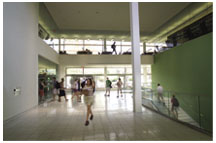
1. Students stroll though the airy atrium of the Friend Center for Engineering Education (Pei Cobb Freed & Partners, 2001), on the corner of Olden and William Streets across from the E-Quad. Dennis Keller ’63 helped fund the center in memory of his childhood friend and Princeton classmate, Peter Friend ’63, who died in an accident during their junior year.
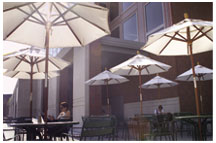
2. Seating outside Frist Campus Center (Venturi, Scott Brown, 2000) became a favorite spot as the weather heated up, especially during a mid-April heat wave.
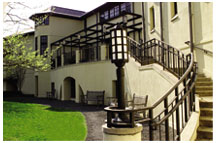
3. The Center for Jewish Life (Robert A. M. Stern, 1993), located on Washington Road just south of Terrace Club, was designed to provide an eating-club-like environment for Princeton’s Jewish students. Writes Raymond Rhinehart *69 in Princeton University: The Campus Guide (1999), “The Center conveys the air of being a long-time neighbor rather than an interloper.”
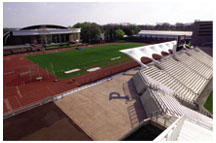
4. Weaver Track (Rafael Viñoly, 1998) flows seamlessly out of Princeton’s football stadium. Placing the track outside the football stadium allowed Viñoly to make Princeton Stadium smaller (30,000 seats, down from Palmer’s 46,000) and more intimate. Both structures have earned widespread acclaim — no mean feat in the Princeton community.
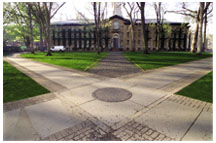
5. The green in front of Nassau Hall received an overhaul last year, with refinished and releveled paths of bluestone and cobblestone. The landscaping work is part of a five-year master plan by Quennell Rothschild & Partners to enhance the open spaces in the historic part of campus. The initial work began in summer 2000 with the renovation of Hamilton Courtyard, which is shown in picture 6.
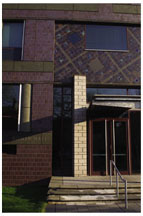
1. Bowen Hall (Alan Chimicoff, Hillier Group, 1992) houses the Princeton Materials Institute, and its façade seems to announce that function, with terra cotta, tile, and polished steel all vying for attention. The Materials Institute offers a certificate for undergraduates and a doctoral degree program for graduate students. Bowen is on Prospect Avenue across from Charter Club.
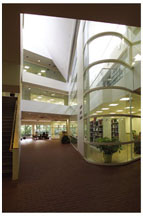
2. Woolworth Music Center was renovated and expanded in 1996 by Juan Navarrow Baldeweg, bringing light and, finally, a little harmony to the original 1963 building. The atrium, shown here, soars several stories and houses the futuristic Mendel Music Library, named for Arthur Mendel, who was chair of the music department from 1952 to 1967 and Henry Putnam University Professor until he retired in 1973.
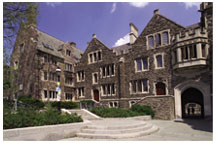
3. Wright Hall (formerly known as Patton) was the first dormitory to be renovated. In addition to a new roof, electrical, plumbing, and heating systems, and new bathrooms (no longer in the basement!), Wright gained new rooms from previously unused attic space and more common space to help combat the isolation of its traditional entryway system. In addition, renovators carved out an archway between the second and third entries, creating an entry into Wilson College from Elm Drive and, beyond, the Dinky station. The path through the arch takes a visitor all the way to the south entrance of Frist.
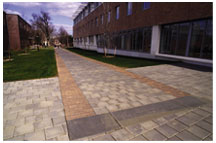
4. Shapiro Walk runs from Washington Road alongside the Woodrow Wilson School (Robertson Hall), leading into a manicured new quad defined by Wallace Social Science Center (Bohlin Cywinski Jackson, 1999), shown, the Friend Center, a recent addition to the Princeton University Press Building, and the Computer Science Building (Kliment and Halsband, 1989).
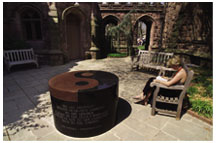
5. In honor of its 25th reunion in 1994, the Class of 1969 donated this marble sculpture and the garden behind Murray-Dodge. The lyrics inscribed on the stone, from Joni Mitchell’s famous song “Woodstock,” conjure up the spirit of the class’s Princeton era.
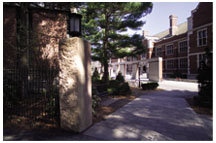
6. Walking out of Prospect Garden today brings a visitor to the new heart of campus: Frist Campus Center, with its distinctive north arcade.
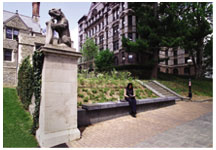
7. A terrace, a gift to James E. Crawford ’68 from
his wife, Alicia, and children Lacy ’96 and James ’03, provides
a sunny seat at the start of what’s known as McCosh Walk, leading
from the U-Store out to Washington Road. ![]()
For an interactive campus map detailing the new construction at Princeton during the past 15 years, visit PAWPlus at www.princeton.edu/paw/plus, May 15th issue.
Also on PAWPlus, find Dennis Keller’s moving speech at the dedication of the Friend Center.
